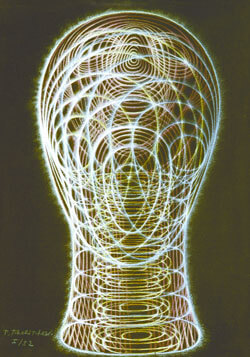Vestry Arts juxtaposes DiBennedetto, Schoolwerth with Bellmer and Tchelitchew
Notions of greatness excite and revolt serious and not-so-serious artists everywhere.
But as one gets closer to the nexus of greatness—a pig’s litter of critics, artists, dealers, and collectors who get their chance to decide—one realizes the description is silly. Very often, the difference between great and not-quite great is a weird stew of happenstance and momentum. Still, the assertion is continually made, “There’s no great art now; it just ain’t what it used to be.”
In the inaugural show at Vestry Arts, Miguel Abreu, properly disregarding such atavism, has grouped drawings by contemporary artists Steve DiBennedetto and Pieter Schoolwerth with Hans Bellmer (1902-75) and Pavel Tchelitchew (1898-1957). DiBennedetto and Schoolwerth are an unlikely match; DiBennedetto known for his gloppy and colorful abstract excesses, Schoolwerth for his tightly conceived and rendered madhouse realism. Bellmer and Tchelitchew, notwithstanding that they may be a better coupling in historical retrospect, represent equally distinct iconographies—Bellmer with his surrealist foundation and heteroerotic photography, Tchelitchew with a view of “internal landscape” specifically set apart from surrealism, and an often homoerotic subject matter.
Yet the drawings of these various artists relate—most immediately in terms of a shared positioning to political history (the onset of the Cold War vis-à-vis the onset of the war on terror), as well as regarding the occult and the psychedelic.
Moving through the works, and the century, the intention of both Bellmer and Tchelitchew to literally dissect society as represented by the fetishized body are followed up by DiBennedetto’s and Schoolwerth’s investigations of a culture in which the body itself is no longer the object of the fetish, rather, the culture at large is the source of arousal.
DiBennedetto and Schoolworth, whose bodies of works are but preliminarily known in comparison to those of Bellmer and Tchelitchew, not only gain from the company, but also from being afforded the larger context. Familiarization with Schoolwerth’s drawings, and his broad and fuzzy engagement of popular culture, enhances the solidity of his intentionally slick and impenetrable oil tableaus; while the dictatorial control of DiBennedetto’s colored pencils similarly benefits the looser compositions of his canvases.
So, as for art being less than it was—you get what you put into it.
Go see the show.


































